“LED strip remote issues like unresponsiveness or intermittent control often result from weak batteries, interference, or pairing problems. Clearly understanding these common causes allows you to quickly fix your remote and maintain reliable lighting control.”
Introduction to LED Strip Remote Issues
From my hands-on experience installing and troubleshooting LED strip lighting, I clearly understand how frustrating remote control issues can be. If your LED strip remote is unresponsive, intermittently working, or failing entirely, it can significantly disrupt your lighting setup and overall experience.
What Are Common LED Strip Remote Issues?
Typical issues include the remote not responding, inconsistent signal strength, flickering or irregular control, or complete remote failure. Clearly identifying these common symptoms helps you quickly address and resolve remote control problems.
Importance of Quickly Fixing Remote Issues
Promptly troubleshooting remote issues ensures reliable control, convenience, and efficient lighting operation. Clearly addressing these problems early also prevents frustration and ensures your lighting setup remains fully functional.
Clients frequently ask me, “Why is my LED strip remote suddenly not working?” Clearly, understanding common causes and straightforward fixes can quickly restore reliable remote control functionality.

Common Causes of LED Strip Remote Failure
From my practical experience troubleshooting LED strip remotes, I clearly understand the typical reasons they stop working. Here’s a straightforward guide to quickly identify and resolve these common remote issues:
Dead or Weak Batteries
- Issue Clearly Explained:
Weak or depleted batteries cause the remote to become unresponsive or work intermittently.
- How to Identify:
Remote responsiveness decreases clearly over time, eventually leading to total unresponsiveness.
Signal Interference or Obstruction
- Issue Clearly Explained:
Obstructions or interference from other electronic devices can block the remote signal, causing irregular functionality.
- How to Identify:
Remote responsiveness clearly improves when closer to the LED controller or after removing nearby interference sources.
Pairing or Connection Issues
- Issue Clearly Explained:
Remote losing pairing with the LED controller results in failure to control LED strips.
- How to Identify:
LED strips clearly fail to respond despite a functioning remote and good battery.
Faulty Remote Control
- Issue Clearly Explained:
Damaged or malfunctioning remotes cause complete or partial failure of remote functionality.
- How to Identify:
Remote clearly fails even after battery replacement and pairing attempts.
Comparison Table:
| Issue |
Symptoms |
Quick Solutions |
| Dead Batteries |
Remote unresponsive |
Replace batteries clearly |
| Signal Interference |
Remote response irregular |
Remove interference clearly |
| Pairing Issues |
Remote not controlling LEDs |
Reset and re-pair remote clearly |
| Faulty Remote |
Complete failure |
Replace remote clearly |
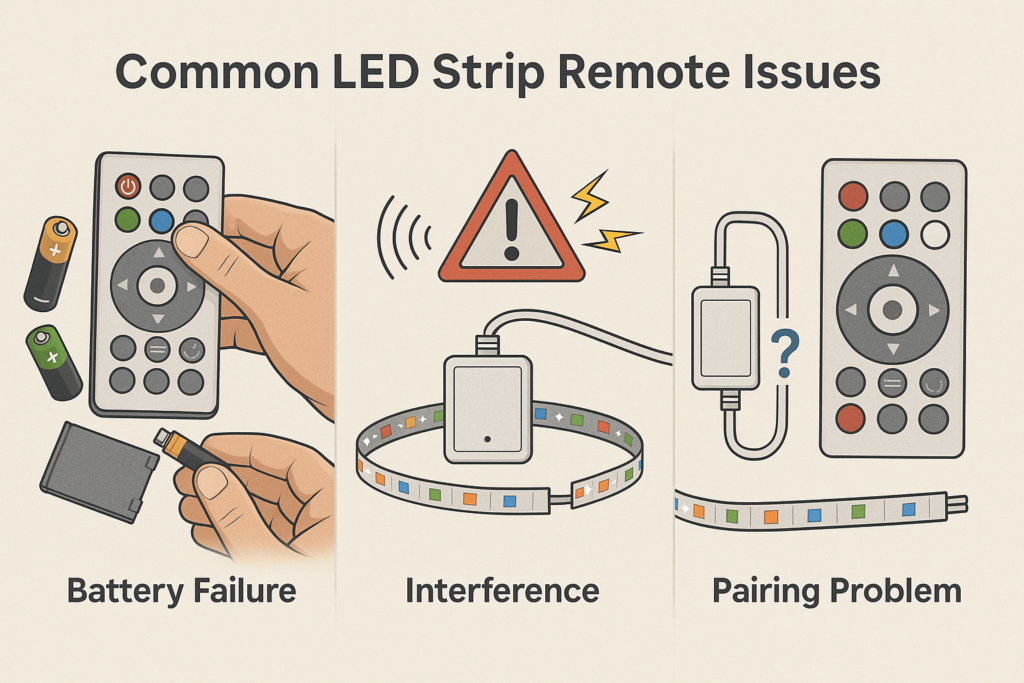
Step-by-Step Guide to Fixing LED Strip Remote Issues
Based on extensive personal experience troubleshooting LED strip remotes, I clearly understand the fastest, easiest methods to restore functionality. Here’s a straightforward step-by-step guide to quickly fix your LED strip remote problems:
Step 1: Check and Replace Batteries
- Clearly remove old batteries from your remote.
- Insert fresh, high-quality batteries clearly matching your remote’s specifications.
- Test the remote clearly after battery replacement to confirm functionality.
Step 2: Eliminate Signal Interference and Obstructions
- Clearly remove potential obstacles or interference sources, such as other electronics or metal objects near the LED controller.
- Ensure a clear, direct line of sight between the remote and LED controller.
Step 3: Reset and Re-Pair the Remote
- Follow manufacturer instructions clearly to reset the remote control and the LED strip controller.
- Re-pair the remote clearly with your LED strips according to provided guidelines.
Step 4: Replace Faulty Remotes or Controllers
- If issues persist clearly after steps 1-3, replace your remote control or LED controller with a compatible, high-quality unit.
- Ensure clear compatibility with your LED strips to restore proper functionality.
Clients frequently ask me, “Can I quickly fix LED strip remote issues myself?” Clearly, following these straightforward troubleshooting steps will usually restore reliable remote functionality quickly and effectively.
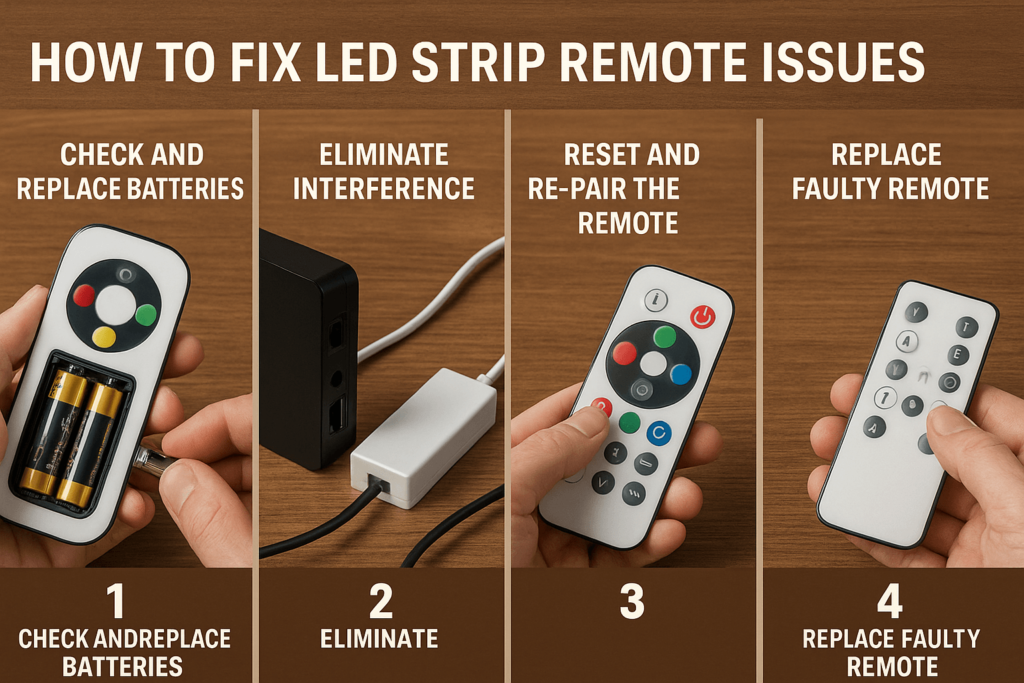
Advanced Troubleshooting Techniques for Persistent Issues
Based on my extensive experience handling persistent LED strip remote problems, here’s clear, practical advice for addressing complex or stubborn remote control issues effectively:
Advanced Tip 1: Use a Signal Extender or Repeater
- Clearly consider installing a remote signal extender or repeater to enhance signal strength and range.
- Clearly position extenders strategically to eliminate persistent interference or signal blockage.
Advanced Tip 2: Verify and Update Remote Compatibility
- Clearly verify the remote and LED strip controller compatibility; consult manufacturer guidelines.
- Consider clearly upgrading to a universal or advanced controller for improved reliability.
Advanced Tip 3: Test and Replace LED Controllers
- Clearly test your LED controller separately using another compatible remote.
- If the controller fails consistently, clearly replace it with a reliable, high-quality model.
Advanced Tip 4: Inspect and Improve Remote Signal Path
- Inspect clearly for hidden obstructions or interference (such as large appliances or electronics) near the remote or controller.
- Clearly relocate controllers or rearrange the setup to optimize the remote signal pathway.
Clients often ask me, “What advanced methods can help fix stubborn remote issues?” Clearly, addressing compatibility, using signal extenders, and carefully inspecting signal paths provide effective solutions to persistent LED remote problems.
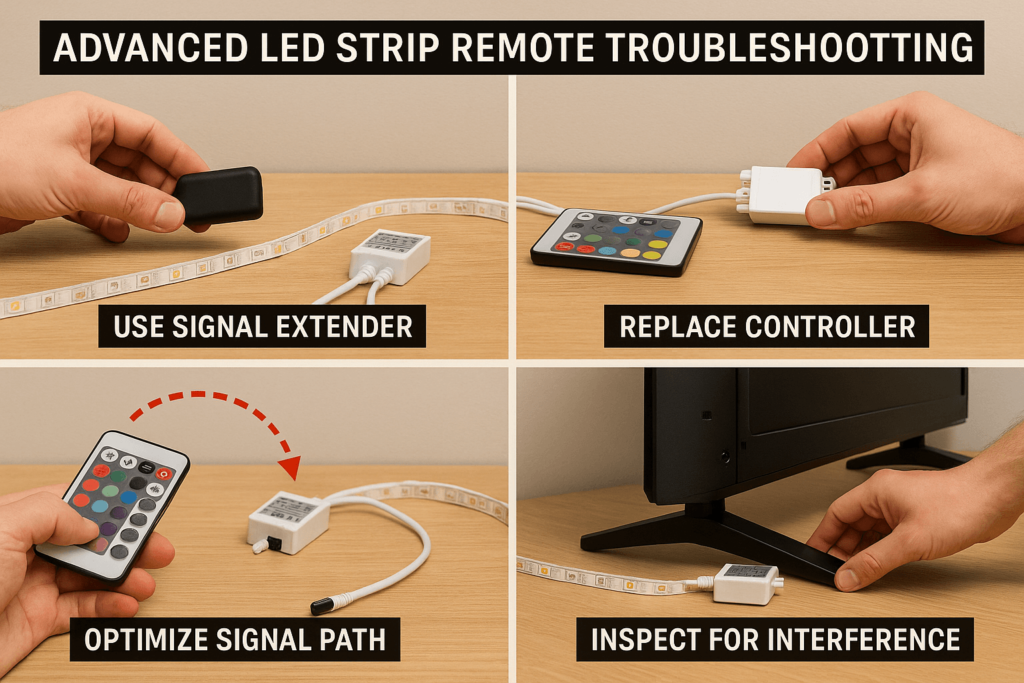
Alternative Control Options for LED Strips
From my extensive experience installing LED strip lighting, I clearly understand the value of having alternative control methods in case your LED strip remote continues to malfunction. Here’s a straightforward guide to effective alternative control solutions:
Smartphone App-Based Controls
- Clearly choose compatible smartphone apps designed specifically for controlling LED strips via Bluetooth or Wi-Fi.
- Apps like Magic Home, Govee, or Philips Hue clearly provide reliable, intuitive LED strip control.
Universal LED Remotes
- Clearly select universal remotes designed for broad compatibility with various LED strip controllers.
- These universal solutions clearly offer reliable replacements for malfunctioning or lost original remotes.
Wi-Fi or Smart Home Controllers
- Clearly integrate your LED strips with smart home platforms such as Amazon Alexa or Google Assistant for convenient voice control and automation.
- Smart controllers clearly offer stable, reliable operation and remote control via smartphone or smart speakers.
Physical Wall-Mounted Controls
- Install physical, wall-mounted dimmers or control panels clearly designed for LED strip lighting.
- Clearly provide convenient, stable lighting control without reliance on handheld remotes.
Clients often ask me, “What if my LED strip remote stops working completely?” Clearly, exploring alternative control options like smartphone apps, universal remotes, or smart home integration ensures reliable and convenient LED strip operation.
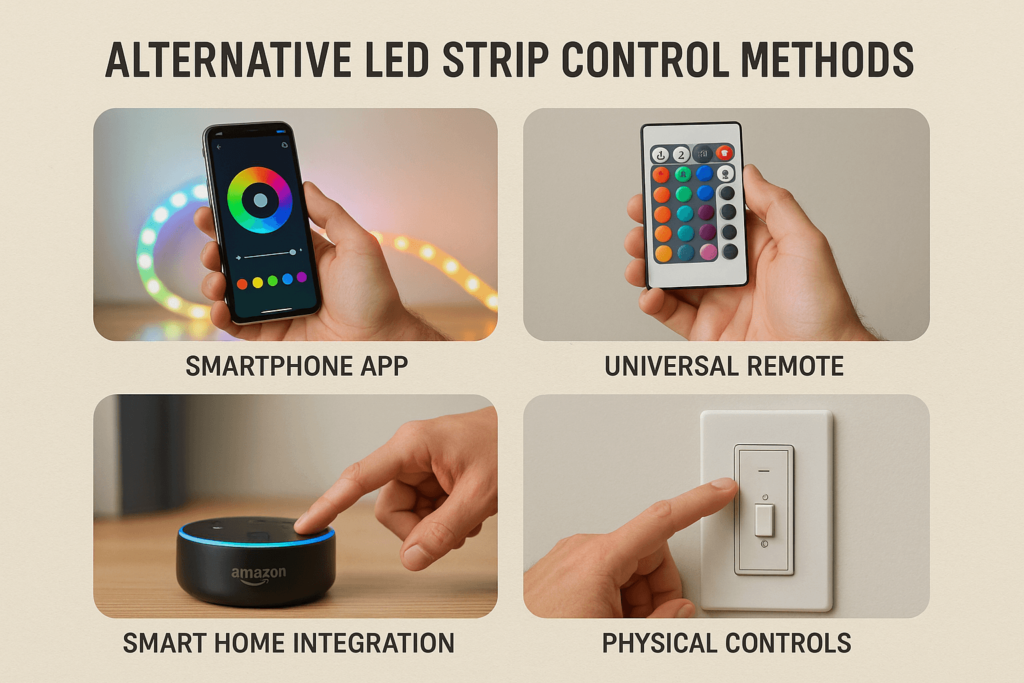
Recommended Components for Reliable LED Remote Control
From my hands-on experience troubleshooting LED strip remote issues, selecting the right components is crucial for consistent, reliable performance. Here’s straightforward advice on choosing high-quality components and tools for your LED remote control:
High-Quality Replacement Remotes
- Clearly select remotes from reputable manufacturers designed specifically for LED strip compatibility.
- Choose universal LED remotes clearly known for reliability and consistent performance.
Reliable LED Controllers
- Clearly ensure controllers match your LED strips precisely, supporting features like dimming, color changing, and remote pairing.
- Upgrade clearly to high-quality, reputable LED controllers to prevent persistent remote issues.
Quality Batteries
- Clearly use high-quality alkaline or lithium batteries for long-lasting remote control performance.
- Replace batteries clearly at regular intervals to maintain consistent remote responsiveness.
Signal Extenders & Repeaters
- Clearly use remote signal extenders or repeaters to ensure robust signal strength and eliminate interference or range issues.
Smart Home or App-Based Controllers
- Clearly integrate your LED strips with smart controllers or app-based solutions for additional reliability and convenience.
Clients frequently ask me, “What components ensure my LED strip remote remains reliable?” Clearly, choosing quality remotes, compatible controllers, reliable batteries, and effective signal boosters ensures stable remote control performance.
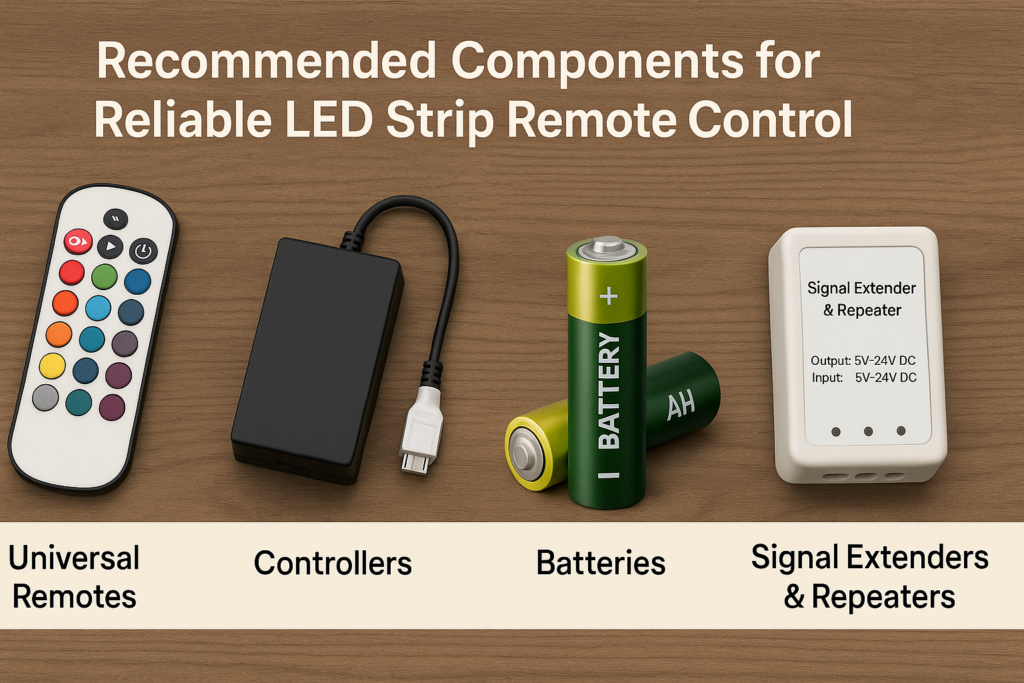
Preventing Future LED Strip Remote Issues
From extensive experience installing and troubleshooting LED strip lighting, I clearly understand how proactive measures can help prevent remote issues. Here’s straightforward, practical guidance to maintain reliable, long-term remote performance:
Regular Battery Replacement
- Clearly replace remote batteries regularly, even before they completely fail.
- Keep fresh, high-quality batteries on hand clearly to maintain consistent remote functionality.
Proper Remote Handling and Storage
- Clearly store remotes away from moisture, direct sunlight, and extreme temperatures to preserve performance and lifespan.
- Handle remotes gently, clearly avoiding dropping or exposure to liquids.
Avoid Signal Interference
- Clearly position LED controllers in clear, unobstructed locations to maintain strong remote signals.
- Clearly minimize potential interference from other electronic devices or large metallic objects near your LED setup.
Routine Inspections
- Periodically inspect remote connections, LED controllers, and batteries clearly to ensure everything functions properly.
- Clearly address any signs of remote issues quickly before they escalate.
Clients often ask me, “How can I easily prevent LED strip remote problems?” Clearly, following these simple, preventive measures helps ensure consistent, reliable remote performance for your LED strip lighting long-term.
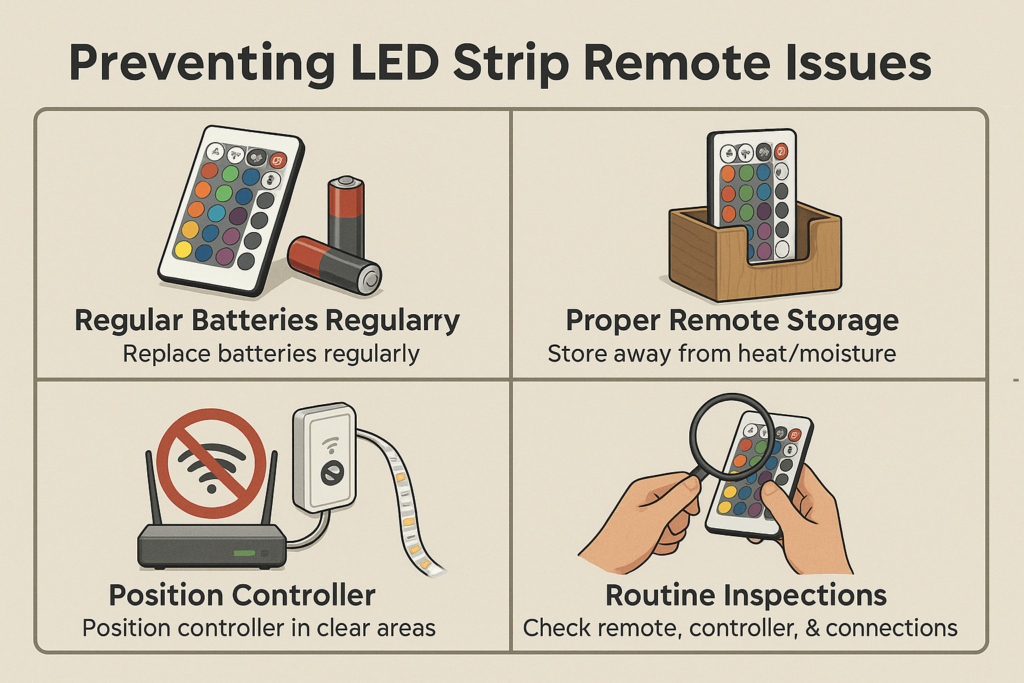
Expert Maintenance & Long-term Care Recommendations
Having installed and maintained many LED strip remotes, I clearly understand that consistent care and regular maintenance ensure long-term reliability and performance. Here’s clear and straightforward guidance to keep your LED strip remote functioning optimally over time:
Regular Inspections and Testing
- Clearly schedule regular inspections to ensure remote buttons, battery compartments, and LED controllers are functioning well.
- Quickly address minor issues clearly before they become larger problems.
Proper Battery Maintenance
- Clearly replace batteries periodically—even before complete failure—to maintain consistent remote responsiveness.
- Use high-quality alkaline or lithium batteries clearly designed for longer lifespan and reliable performance.
Cleaning and Remote Care
- Gently clean remote surfaces and buttons clearly using a soft cloth, removing dirt and debris that can hinder responsiveness.
- Clearly avoid harsh chemicals or moisture that might damage remote electronics.
Safe Storage Practices
- Clearly store remotes in safe, dry areas away from extreme temperatures, moisture, and direct sunlight.
- Clearly protect remotes from falls or impacts to prolong their effective lifespan.
Clients often ask me, “How often should I perform maintenance on my LED remote?” Clearly, regular monthly inspections, gentle cleaning, and periodic battery replacements ensure your LED strip remote remains reliable and responsive.
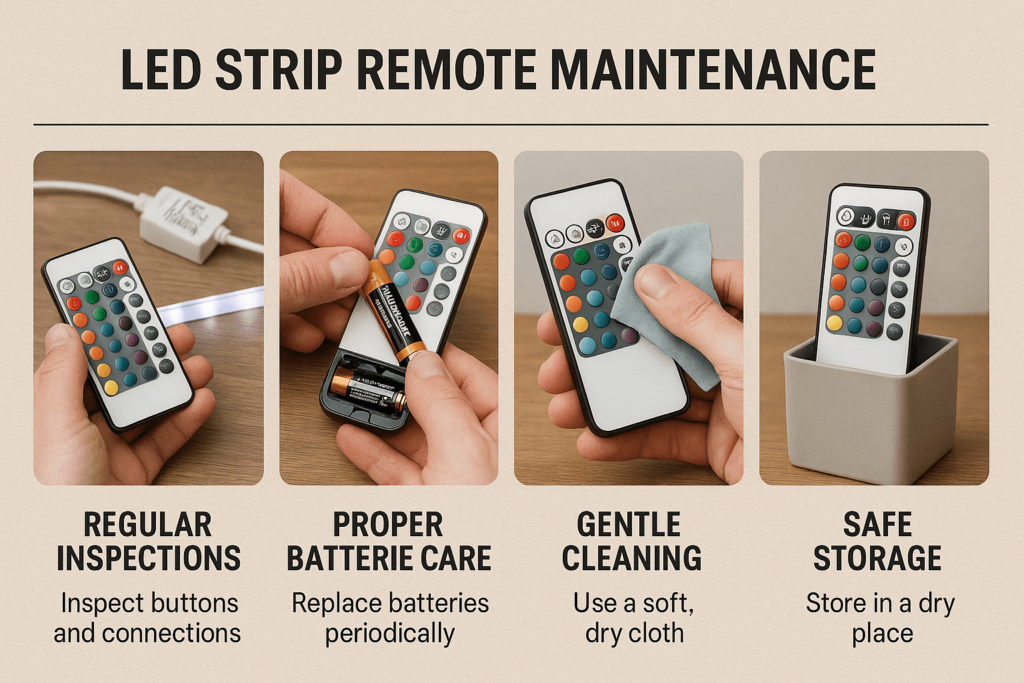
FAQs About LED Strip Remote Not Working
Drawing from my practical experience handling LED strip remote issues, here are clear, practical answers to frequently asked questions, helping you quickly resolve remote control problems:
Why won’t my LED strip remote work?
Your LED strip remote may fail due to dead batteries, signal interference, pairing issues, or a faulty remote. Clearly checking these common causes usually resolves the issue quickly.
How can I reset my LED strip remote?
Typically, clearly reset your remote by disconnecting the power, removing batteries, waiting a few seconds, then reconnecting power and reinserting fresh batteries. Clearly re-pair according to your remote’s instructions.
Can I replace or upgrade my LED strip remote easily?
Yes, clearly. You can easily replace or upgrade your LED remote using universal remotes, smartphone apps, or smart home integrations compatible with your LED controller.
Conclusion & Next Steps
Clearly understanding common reasons for LED strip remote issues—such as battery failures, interference, or pairing problems—enables you to quickly resolve these issues and maintain reliable control. From my extensive installation and troubleshooting experience, regular preventive maintenance, careful component selection, and proper remote handling significantly reduce remote control problems over time.
Ensure reliable LED strip remote functionality by regularly inspecting your setup, promptly replacing batteries, and using quality remotes and controllers.
Ready to achieve stable, trouble-free LED strip control?
Explore Elstar’s LED Lighting Solutions →









